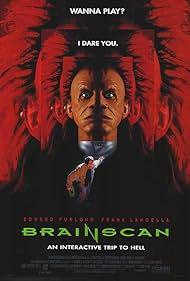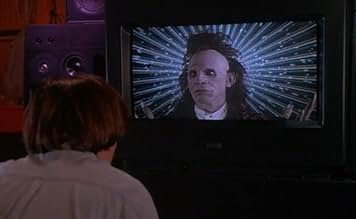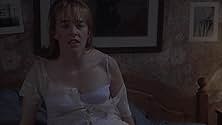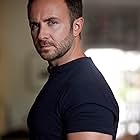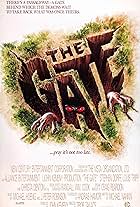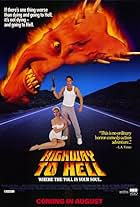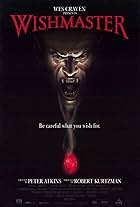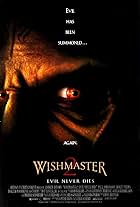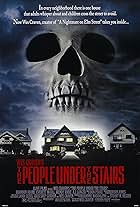A teenager is part of an interactive video game where he kills innocent victims. Later, the murders become real.A teenager is part of an interactive video game where he kills innocent victims. Later, the murders become real.A teenager is part of an interactive video game where he kills innocent victims. Later, the murders become real.
- Awards
- 1 nomination
Jamie Galen
- Kyle
- (as a different name)
Domenico Fiore
- Ken
- (as Dom Fiore)
Tod Fennell
- Young Michael
- (as Tod Fennel)
Michèle-Barbara Pelletier
- Stacie
- (as Michele-Barbara Pelletier)
Donna Baccala
- Mrs. Keller
- (as Donna Bacalla)
Jérôme Tiberghien
- Mr. Tebb
- (as Jerome Thiberghian)
- Directors
- Writers
- All cast & crew
- Production, box office & more at IMDbPro
Storyline
Did you know
- TriviaDirector John Flynn did not get along with Edward Furlong during filming. He later recalled, "Eddie Furlong was a 15-year-old kid who couldn't act. You had to slap him awake every morning. I don't want to get into knocking people, but I was not a big Eddie Furlong fan."
- GoofsMichael's area code is 717 which is located in Eastern Pennsylvania. However if you look closely at the letters that he sorts through and finds the Brainscan package, the state that he lives in is actually New Jersey.
- Quotes
[Michael answers Dr. Fromberg as to why he likes watching horror films]
Michael: I guess it's kind of an escape.
Dr. Fromberg: Like, uh... lighting up a marijuana cigarette and escaping the real world, hmm? Like watching a pornographic sex film, getting an erection and raping someone? Is that what you mean?
Michael: You know, I don't think erections rape people. People rape people.
- Crazy creditsAs the end credits start, we hear Trickster say "Wait a minute. Haven't you forgotten something?" and the credits screen shatters as if it was made of glass. It then shows a scene involving the dog with the dismembered foot from earlier in the film, and then the end credits resume.
- Alternate versionsThe UK Guild video was cut by 58 secs with edits to a scene where a man is repeatedly stabbed and his foot severed. The cuts were waived for the Optimum DVD release.
Featured review
Michael Brower (Edward Furlong), a lonely fan of horror films and video games still suffers from lingering trauma (both physical and mental) as a result of a vehicular collision that disabled his leg and killed his mother. Michael's niche interests are a point of ridicule for the student body and a point of contention for the faculty who equate such interest on the level of rape and narcotics. When Michael's only friend, Kyle (Jamie Marsh) tells him of a new interactive horror game called Brainscan, Michael calls the info number and is sent a copy without having placed an order. The game delivers on fear, but the presence of a malevolent entity known as The Trickster (T. Ryder Smith) blurs the lines of reality with the horror of the game appearing in real life.
Brainscan was one of the few Slashers still released to cinemas in a time where the genre was mostly on the decline and entries were dumped on Home Video or cable. While slasher series such as Leprechaun, Child's Play, and Candyman did emerge during the 90s, most of them couldn't hold audience interest and were met with either diminishing margins or sequels going straight to video. One of the last film's to be released by Gaumont/Columbia joint venture Triumph Releasing Corporation before reorganizing as Sony Releasing Corporation, Brainscan was a critical and box office disappointment upon release opening at a dismal 10th place upon initial release and withdrawing from theaters two weeks later. While Brainscan isn't a lost horror classic by any means, I think it does have more on its mind than most give it credit for.
The movie was released shortly after the moral panic on video games in the early 90s spawned by games such as Night Trap and Mortal Kombat that lead to the congressional inquiries of 1993 as well as the establishment of the ESRB so the industry could self regulate (not unlike the moral panic of the 30s that put an end to Pre-Code Hollywood with the establishment of the Hayes Code). Brainscan has a rather subversive attitude to its subject matter, playing devil's advocate for gory horror films and violent video games at a time when they were very much under attack. The movie even goes into breakdowns of the appeal behind this kind of entertainment with Edward Furlong's character Michael discussing such entertainment as an escape while David Hembeln's Dr. Fromberg makes hyperbolic statements on Michael's entertainment choices comparing viewing of horror films to Rape in one scene. Even once the terror of the movie begins, the movie uses its framework as a way of breaking down how we project ourselves into these types of entertainment as a way of contrasting and exploring our underlying fears in a fantastical exaggerated sense that serves as an outlet to help us understand our fears. It's a really smart breakdown of horror that feels genuine.
While the movie's take on horror from an analytical view is certainly well done, the movie as a horror film itself will be somewhat disappointing to people expecting a fright fest. T. Ryder Smith as The Trickster, a entity who appears to Michael through the video game and makes causal wise cracks about murder and mayhem is trying to be a digitized take on Freddy Kruger, but at no point is he legitimately scary and I'd equate him more with something like Beetlejuice but even Beetlejuice could be a little threatening despite being a comedic character. The Trickster I found more aggravating than funny or intimidating and the choice to model the character with an exaggerated Punk Rock style just seemed more confusing than anything else. Most of the kills in Brainscan happen off camera, and even when we do see them they're fairly tame in comparison to the high points of kill scenes in Friday the 13th or Nightmare on Elm Street. Brainscan while interesting in playing Devil's advocate for Horror films and video games isn't really all that interested in being a horror movie itself and plays more like a dark comedy.
While Brainscan will be disappointing to those expecting a digitized Nightmare on Elm Street as promised by the advertisements, Brainscan shouldn't be completely written off. The movie isn't all that scary, but it tackles the genre from a deconstructionist point of view looking at the appeal behind the genre and the purpose it serves its fans. While the movie doesn't want to be a horror film itself, it's production design and attitudes shows a real love, respect, and understanding of the genre. As long as people set their expectations correctly and are okay with a darkly comic coming of age story that happens to have horror iconography without much actual horror, Brainscan shows it does have a brain.
Brainscan was one of the few Slashers still released to cinemas in a time where the genre was mostly on the decline and entries were dumped on Home Video or cable. While slasher series such as Leprechaun, Child's Play, and Candyman did emerge during the 90s, most of them couldn't hold audience interest and were met with either diminishing margins or sequels going straight to video. One of the last film's to be released by Gaumont/Columbia joint venture Triumph Releasing Corporation before reorganizing as Sony Releasing Corporation, Brainscan was a critical and box office disappointment upon release opening at a dismal 10th place upon initial release and withdrawing from theaters two weeks later. While Brainscan isn't a lost horror classic by any means, I think it does have more on its mind than most give it credit for.
The movie was released shortly after the moral panic on video games in the early 90s spawned by games such as Night Trap and Mortal Kombat that lead to the congressional inquiries of 1993 as well as the establishment of the ESRB so the industry could self regulate (not unlike the moral panic of the 30s that put an end to Pre-Code Hollywood with the establishment of the Hayes Code). Brainscan has a rather subversive attitude to its subject matter, playing devil's advocate for gory horror films and violent video games at a time when they were very much under attack. The movie even goes into breakdowns of the appeal behind this kind of entertainment with Edward Furlong's character Michael discussing such entertainment as an escape while David Hembeln's Dr. Fromberg makes hyperbolic statements on Michael's entertainment choices comparing viewing of horror films to Rape in one scene. Even once the terror of the movie begins, the movie uses its framework as a way of breaking down how we project ourselves into these types of entertainment as a way of contrasting and exploring our underlying fears in a fantastical exaggerated sense that serves as an outlet to help us understand our fears. It's a really smart breakdown of horror that feels genuine.
While the movie's take on horror from an analytical view is certainly well done, the movie as a horror film itself will be somewhat disappointing to people expecting a fright fest. T. Ryder Smith as The Trickster, a entity who appears to Michael through the video game and makes causal wise cracks about murder and mayhem is trying to be a digitized take on Freddy Kruger, but at no point is he legitimately scary and I'd equate him more with something like Beetlejuice but even Beetlejuice could be a little threatening despite being a comedic character. The Trickster I found more aggravating than funny or intimidating and the choice to model the character with an exaggerated Punk Rock style just seemed more confusing than anything else. Most of the kills in Brainscan happen off camera, and even when we do see them they're fairly tame in comparison to the high points of kill scenes in Friday the 13th or Nightmare on Elm Street. Brainscan while interesting in playing Devil's advocate for Horror films and video games isn't really all that interested in being a horror movie itself and plays more like a dark comedy.
While Brainscan will be disappointing to those expecting a digitized Nightmare on Elm Street as promised by the advertisements, Brainscan shouldn't be completely written off. The movie isn't all that scary, but it tackles the genre from a deconstructionist point of view looking at the appeal behind the genre and the purpose it serves its fans. While the movie doesn't want to be a horror film itself, it's production design and attitudes shows a real love, respect, and understanding of the genre. As long as people set their expectations correctly and are okay with a darkly comic coming of age story that happens to have horror iconography without much actual horror, Brainscan shows it does have a brain.
- IonicBreezeMachine
- Apr 9, 2021
- Permalink
Details
Box office
- Gross US & Canada
- $4,352,094
- Opening weekend US & Canada
- $1,725,000
- Apr 24, 1994
- Gross worldwide
- $4,352,094
- Runtime1 hour 36 minutes
- Color
- Sound mix
- Aspect ratio
- 1.85 : 1
Contribute to this page
Suggest an edit or add missing content

